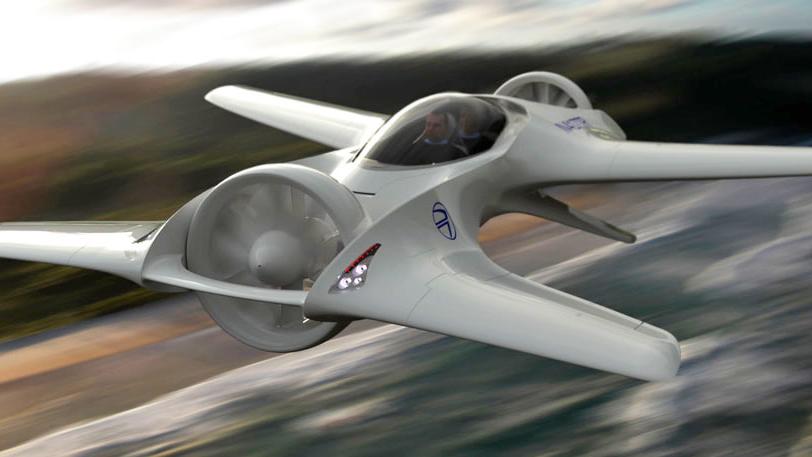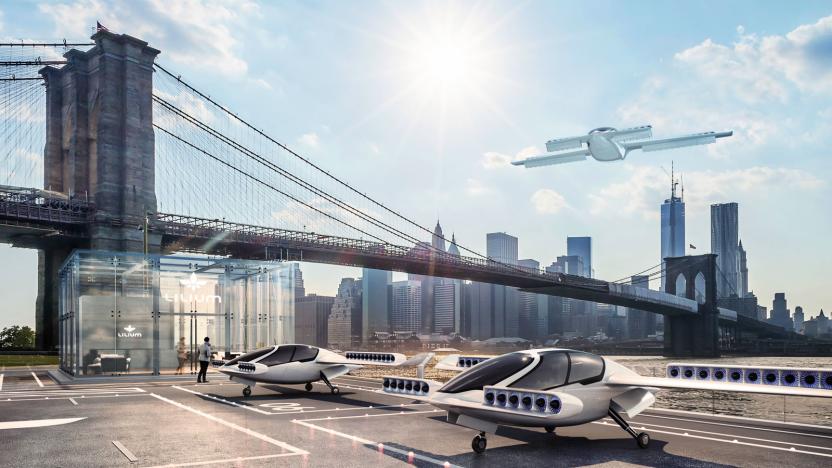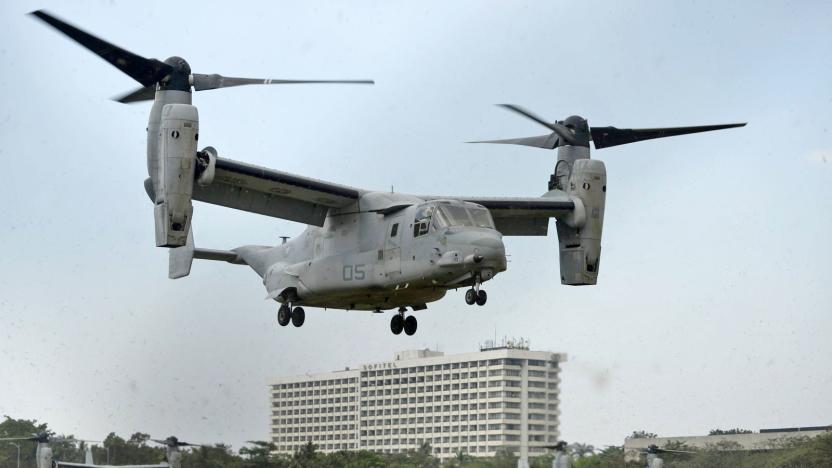VTOL
Latest

Lilium secures $90 million to develop its electric VTOL plane
Like a few other startups, Lilium wants to make our flying car dreams come true with an electric VTOL craft you can summon with an app. Thanks to $90 million worth of new investment from China's Tencent and others, the startup may now have a leg up on its rivals. It will use the funds to drastically expand hiring in order to take the electric jet into the next stages of development.

DeLorean's next car is a flying one
Paul DeLorean isn't as famous as Larry Page, Airbus or Uber, but he's competing with all three in the race to build a flying car. DeLorean does have a famous name, however, and is the nephew of the John DeLorean, maker of the eponymous sports car made famous by Back to the Future. In a profile at Wired, the youger DeLorean reveals his plans for the DeLorean DR-7, a two-seater VTOL craft for personal transport.

Uber wants to test its flying taxis by 2020
Today in Dallas, Uber is taking the wraps off its flying car plans. The company's three-day "Elevate" summit is meant to discuss all things relating to vertical take-off and landing (VTOL) craft and how Uber sees them as a major part of its future strategy. Probably the biggest news coming out of the opening keynote, which just wrapped a few minutes ago, is Uber's ambition to demonstrate its Elevate Network in 2020 -- an aggressive goal, to be sure.

Lilium's electric personal jet manages a vertical takeoff
The Lilium jet may look like somebody's wacky concept of a futuristic aircraft that will never be able to fly, but that couldn't be further from the truth. It has recently completed a series of flight tests in Munich, Germany, proving that the first all-electric vertical takeoff and landing (VTOL) jet is capable of taking to the skies. The company even released a video of Lilium's maiden flight, which you can watch after the break.

DARPA successfully flew a model of its 24-fan electric plane
DARPA's experimental Vertical Takeoff and Landing (VTOL) aircraft, the XV-24A LightningStrike, cleared another developmental hurdle by completing its subscale flight tests in early March, according to its manufacturer, Aurora Flight Sciences.

Artist runs an electronic sound exhibit using his own blood
Russian artist Vtol is no stranger to making sounds with unusual technology, but one of his latest projects might top them all. He recently created Until I Die, an electronic sound installation powered by himself -- namely, his blood. His creation uses vital fluid as an electrolyte that, when combined with metals like aluminum and copper, results in direct current batteries. The project isn't about to compete with the battery in your phone (five batteries manage a capacity of just 1,000mAh), but that's enough to power a synth module and speaker for roughly 8 hours.

Uber hires a NASA guru to help it understand flying cars
Uber is eager for the day when you can take a flying car across town, and it just landed a key hire that could help make this a reality. The company has recruited Mark Moore, NASA's technology lead for on-demand mobility, as its director of engineering for aviation. This doesn't mean that the ridesharing firm will build its own flying cars, at least not any time soon -- rather, he wants to "make this market real." That will likely involve solving technical obstacles that Uber's hardware partners face, such as extending the range of electric aircraft or reducing noise pollution.

If someone else makes flying cars happen, Uber will be ready
While most of us consider flying cars something that would be cool if they were real, Uber is doing slightly more to make it happen. As profiled by Wired, the transportation company has released a 99-page whitepaper (PDF) titled "Fast-Forwarding to a Future of On-Demand Urban Air Transportation." Does that mean Uber is building flying cars to go along with its self-driving test mules? Nope, but in case someone else wants to do it, Uber is lining up to help make it happen.

Drone flies as both biplane and helicopter using one propeller
There are helicopter drones and fixed-wing drones, but creating a hybrid of both is tricky. Even Parrot's Swing, as clever as it is, needs four propellers and elaborate wings to pull off its stunt. However, TU Delft (with backing from Parrot) has a far more elegant solution. Its DelftAcopter drone doubles as both a fixed-wing aircraft and a helicopter using only one propeller -- its tailless biplane design lets it take off and hover vertically, but gracefully turn into a fast-moving airplane (up to 62MPH) at a moment's notice. It's an incredibly simple design that makes you wonder why someone hadn't considered it for drones before.

Uber explores offering short-hop flights across town
Uber has already resorted to more than one unusual method to get you from one side of town to another, but you haven't seen anything yet. The ridesharing outfit's Jeff Holden tells Recode that Uber is researching the use of VTOL (vertical takeoff and landing) aircraft for short-hop urban flights. It'd potentially speed up long trips, especially in areas where traffic jams might make a conventional ride excruciatingly slow. You could travel from San Francisco to Oakland in 9 minutes, Holden suggests.

This laser-powered drum machine is a stunning work of art
We're big fans of homemade instruments, synthesizers and other noise makers here at Engadget. Russian artist Vtol created a massive laser-powered drum machine installation as part of Earth Lab, a joint project between the Polytechnic Museum Moscow and Ars Electronica Linz. Vtol describes the huge instrument as "an autonomous light-music installation," and it's certainly provides a neat visual to complement its noise making. The setup is officially called "Divider" and it uses seven lasers that pass through fans to send a light signal for generating sound. The laser beams are altered by high-speed fans with a photo sensor on the end monitoring the presence or absence of light.

Personal electric plane won't need an airport
Now that hoverboards are an honest-to-god thing, we have to say we're pretty disappointed with how flying cars have worked out. Another company has jumped into the fray with a vertical take-off plane called the Lilium that can soar at 400 km/h (250 mph). We'd normally say they're dreaming with the specs: A 10,000 foot ceiling, 500 km (310 mile) range and helicopter-like takeoffs, all on battery power. However, it's hosted by a European Space Agency (ESA) incubator and the team from the Technical University of Munich plans manned tests next year.

DARPA unveils its next VTOL aircraft concept
DARPA announced on Thursday that it had awarded the Phase 2 design contract for its unmanned VTOL X-Plane concept to Aurora Flight Sciences (AFS). VTOL (Vertical Take-Off and Landing) planes, like the current generation of V-22 Osprey or F-35B Lightning II, have to trade off between a number of mission requirements including flight speed versus range or fuel efficiency versus power. With the X-Plane, DARPA hopes to have it all and make this VTOL platform more functional on the battlefield.

Listen to a 'CD' made from fool's gold, powered by a Raspberry Pi
What's music to some is noise to others. And that's perhaps most apparent with Ra the latest piece from the creator of an 8-bit camera gun, ::vtol::. As the artist writes in the demo's Vimeo description, the project uses a laser to scan the irregularities on the surface of a pyrite disc. The artist, real-name Dimitry Morozov, says that this disc was a gift from a mineral seller and that all of the tech present was centered around the idea of making a laser sound reader that'd "be able to produce sound from various uneven surfaces." Oh, and Morozov wanted to use the bare minimum tools to make it. What do those include? A Raspberry Pi, Arduino Nano, a homemade laser pickup, stepper motor, servo motor and a three watt mono sound system. If you want to see it in action, you're going to have to hit the Sound Museum in St. Petersburg.

Watch Sony's prototype drone do a vertical takeoff
Aerosense, a joint venture between Sony and ZMP, showed off its first drone which can carry up to 22 pounds, fly continuously for two hours at a speed of 106 miles per hour. It can also take off and land vertically like a helicopter.

Selfie typewriter hammers out ASCII portraits
Dimitry Morozov, better known as vtol, is a Russian musician, engineer and artist who decided that selfies were far too modern for his liking. Instead, he wanted people to wait for their gratification, and so hooked up an iSight camera to an Arduino-controlled Brother sx-4000 typewriter. Once a person sticks their face in front of the machine, named i/o, the typewriter painstakingly hammers out a portrait in ASCII art. The hardware was shown off at the 101 festival in Smolny, St. Petersburg in Russia, which ended earlier this month - but you can still see the device in action if you watch the video.

An autonomous octo-copter transport truck is as amazing as you'd expect
Advanced Tactics' (AT) autonomous Black Knight Transformer may not be small enough to get eaten by an aircraft's engine, but it still falls under the purview of the FAA after completing its first flight. The large and unwieldy-looking beast is lifted by eight motors that swing out from the frame for flight -- though sadly, we don't get a glimpse of the transformation. Designed as a transport system for modular payloads, AT dreams of someday seeing its creation floating a boat by attaching to an amphibious hull, or hauling cargo without the need for a human pilot. In the video after the break, the Transformer slowly putters about and then demonstrates a low altitude hover. Future iterations could see the Black Knight hovering on station for up to 19 hours carrying 150lb (68kg) of ISR gear or delivering up goods with up to 1.75-ton weight limits.

Operational F-35B fighter jet's first vertical landing was years, billions in the making (video)
Lockheed Martin's F-35 program has been a political whipping boy seemingly forever, but a production VTOL 'B'-variant of the pricey supersonic jet finally did what it was made for: a vertical landing. That happened nearly three years to the day after the estimated $304 million (each!) jet's first mid-air hover test, at which point the Pentagon pegged the cost at $83 million. Inflation aside, the US Marine's variant seemed to make a fine, if solid three point landing and Lockheed Martin says it's made considerable strides in the flight testing program over the last couple of years, despite all the overruns and delays. Hopefully that means the US Marines, Britain's Royal Air Force et. al. will be able to deploy that capability on their F-35B's soon -- ie, before they're already obsolete. Check the video after the break. Update: As commenter daveschroeder pointed out, this is the first vertical landing of a production version of the F-35B. Test copies of the fighter (with test pilots aboard) have been performing the feat since late 2011, so we've tweaked the article to make that point clear.

DARPA trying again to develop a high-speed VTOL aircraft
If at first your unmanned aerial vehicles don't succeed... try, try again? After a series of unsuccessful tests with the Boeing X-50 Dragonfly and Groen Heliplane, the US government is once again trying to develop a high-speed, vertical takeoff-and-landing (VTOL) aircraft. DARPA just announced the VTOL X-Plane program, a 52-month, $130 million project with one mission: to build an aircraft that can exceed 300 knots, achieve a hover efficiency of 75 percent or better, and hit a cruise lift-to-drag ratio of 10 or more. In layman's terms, such an aircraft would be faster than a traditional helicopter, but still have better hover efficiency than a modern high-speed 'copter. Sounds like a sensible idea, right? The thing is, DARPA doesn't know yet how such a thing would look: for now, the agency is merely soliciting proposals, with a particular emphasis on smaller, non-traditional companies nimble enough to develop products quickly. So if you've got any good ideas, may as well head on over to the source link, we guess, and try your luck.

US Army breaking up with A160 Hummingbird drone-copter, says it's too high maintenance
It's not me, it's you. The US Army's dalliance with Boeing's A160 Hummingbird drone got one step closer to Splitsville after the military branch issued a stop-work order for the project. Initially scheduled to see action in Afghanistan starting this July, the chopper-drone turned plenty of heads thanks to a DARPA-developed Argus-IS imaging system with a 1.8-gigapixel camera capable of spying on ground targets from 20,000 feet. The honeymoon period between the Army and the A160 is apparently over, however, thanks to a host of issues. These included wiring problems as well as excessive vibration that caused an A160 to crash earlier this year due to a transmission mount failure. The problems not only increased risk and caused delays, but also led program costs to helicopter out of control -- a big no-no given Uncle Sam's recent belt-tightening. In the meantime, the Army is reportedly checking out the K-MAX, though it's important to note that this unmanned chopper specializes in cargo and doesn't have the A160's eyes.











